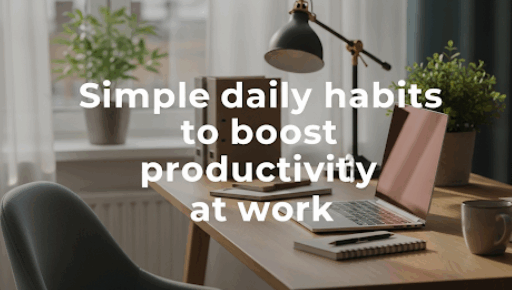Transform Your Mornings, Transform Your Life – Productive Day Morning Routine Ideas
Alarm goes off → you slap Snooze Again. Sound familiar? For most people, the day begins in a rushed bustle of mind-wrangling effort and they quickly feel late before even having worked on anything. But, what if your morning could be different? What if the first few hours of your day really could energize you & be the most amazing way to start each day supported of getting half your fruits and vegetables EACH day!!!
Contrary to what most health gurus or successful entrepreneurs would lead you to believe, a morning routine isn’t the bedrock of success. This is for anyone ready to stop living a reactive life and start being proactive with their time! Studies indicate that individuals who maintain a routine morning schedule are more energetic, focused, and happier.
Ever wonder why a “morning routine” is so wonderful?!! Taking all the guess work out of your early hours, frees up mental energy for the biggest decisions that lie ahead. Here is How: In this article are time-tested morning routine ideas that can help you get things done… make you feel happier… and get you closer to where you want to be!
Why Morning Routines Actually Work
How you start your mornings is how you launch your entire day. Think of it as programming your brain for success before the world has a chance to try and take over.
The Science Behind Morning Success
Your brain is at its peak state of new habit-building and for making important decisions when you first wake up. You never let your willpower run out, this is what we referred to as “decision fatigue resistance”. By creating good habits early on, you set the pace for the rest of your day.
The Power of a Great Morning Routine
- Reduces stress and anxiety
- Increases focus and mental clarity
- Boosts energy levels naturally
- Improves time management skills
- Enhances overall life satisfaction
- Makes you feel accomplished first thing in the morning
According to research from Harvard Medical School, people with morning routines are 42% more likely to reach a goal on any given day than those who get up and wing it.
Foundation — Sleep/Wake Strategy
You must learn how you wake up before you go on to what you do in the morning. This starts the night before.
Smart Sleep Preparation
Consistent Bedtime Your wake-up time is determined by when you go to bed. Sleep: Most adults need 7-9 hours of sleep, so allocate time to sleep. For example if you want to wake up at 6 AM, you should be sleeping by 10-11 PM.
Create a Sleep-Friendly Environment
- Keep your bedroom cool (65-68°F)
- Use Blackout Curtains or Eye Mask for light control
- Take all your electronics out of the bedroom at least 1 hour before bedtime
- Use white noise or earplugs if absolutely necessary
The Perfect Wake-Up Strategy
Avoid the Alarm Snooze Those extra 9 minutes are not restorative. Instead, they make you groggier. If your alarm clock is out of reach, you have to get up to turn it off!
Allow Natural Light Open the curtains as soon as you wake up. Natural light tells your brain to stop making melatonin (the sleep hormone) and start making cortisol (which helps wake you up).
Hydrate As Soon As You Wake Up Drink some water — keep a glass next to your bed or on your bathroom counter. The first thing you should do when you wake up in the morning is rehydrate — your body dehydrates overnight during sleep — and this also gets your metabolism and brain function going.
Physical Wellness: Energize Your Body
Exercising in the morning means more than just going to the gym, exercising doesn’t have to be an expensive process. It is small things that make a big difference.
Movement That Works
The 5-Minute Energy Boost Not a morning exerciser? Start small:
- 20 jumping jacks
- 10 push ups (knee push up, scale if needed)
- 30-second plank
- 10 squats
- Stretch for 2 minutes
It increases blood flow and releases endorphins too without giving you the opportunity to slack.
Morning Walk 10-15 minute walk, exercising outdoors early in the morning (exposure to sunlight). This perfect duo helps set your body clock and gives you a bit of vitamin D exposure, as well as time to ruminate over things with some planning!
Stretching and Yoga Gentle stretching or simple yoga poses can also help to ease the tension from sleep and enhance flexibility. Focus on:
- Neck rolls
- Shoulder shrugs
- Cat-cow stretches
- Forward bends
- Spinal twists
Nutrition That Fuels Success
Hydration
Make sure to drink 16-20oz of water before even your coffee or food. Lemon adds more vitamin C and aids digestion. This liver cleanse drink can also be taken with warm water along with honey and ginger if you want added benefits.
Balanced Breakfast
Your breakfast should not be loaded with sugar. Opt for hearty options that combine protein, fat and carbohydrate:
Quick Protein Options:
- Greek Yogurt with berries and nuts
- Eggs with whole grain toast
- Banana & Spinach Protein Smoothie
- Overnight oats with chia seeds
Foods to Avoid:
- Sugary cereals
- Pastries and donuts
- Too much coffee on an empty stomach
- Processed breakfast bars
Mental Preparation: Prime Your Mind
Everything starts from a clear mind. If it is morning or at the beginning of the working day and you are already muddled… Such habits encourage you to arrange your thoughts and will for good.
Mindfulness and Meditation
Begin with 5 minutes of meditation Meditation does not need talent or tools. Just sit, close your eyes. Focus on the breath in and the breath out. Check in whenever your mind starts to wander, and you start forgetting about your breath.
Guided Options: If you find it challenging to sit in silence, consider the following alternatives:
- Apps that are available for free such as Insight Timer
- YouTube guided meditations
- Basic breathing exercises (Inhale 4 x Hold 4 x Exhale 4)
Benefits You’ll Notice:
- Reduced stress and anxiety
- Better emotional regulation
- Improved focus throughout the day
- Greater self-awareness
Journaling for Clarity
Morning Pages Write three pages (or about 10 minutes) of stream-of-consciousness thoughts. Forget about grammar or sense. This is a well known practice made famous by Julia Cameron’s “The Artist’s Way,” and it helps to clear the clutter from your mind.
Gratitude Practice Write down three things that you are grateful for each morning. Studies reveal that gratitude journaling can boost your levels of happiness and increase positive outcomes.
Intentions instead of To-Do’s Instead of just creating a list of things to do, set intentions for how you want to feel and show up during the day. Examples:
- “I will be curious when faced with challenges”
- “I will approach conversations with patience”
- “I will be infinitely kind to myself”
Goal Setting and Planning
Strategic planning to organize thoughts into action.
The Daily Priority Method
Identify Your Top 3 List the 3 most vital tasks you want to accomplish for that day. If you do nothing else, these three things will make your day a win.
Time Blocking Schedule time blocks for your top priorities. This stops tasks from expanding to fill available time, and keeps you accountable.
Example time-blocking for productivity flow:
- 6:00-6:30 AM: Morning routine (self-care foundation)
- 9:00-11:00 AM: Priority task #1 (high-energy work)
- 2:00-3:00 PM: Priority task #2 (post-lunch focus)
- 4:00-4:30 PM: Priority task #3 (end-of-day momentum)
Weekly and Monthly Planning
Sunday Planning Sessions Schedule 30 minutes on Sundays to review the week ahead. Scan your calendar for projects/events/tasks coming up. This prevents Monday morning scrambling.
Weekly and Monthly Goal Review Spend a little time reflecting on your bigger goals about once a month. Are you making progress in the right direction? What needs adjustment?
Technology and Environment Setup
The quality of your physical and digital environment plays an important role in determining how productive you can be.
Digital Organization
Phone-Free Morning Try implementing a phone-free morning which entails not using your phone until after you have completed your morning routine. Before you even have a chance to set your center, social media and news are tapping into your mental space.
Email Boundaries Do not check email first thing in the morning — designate specific times for checking emails. This keeps other people’s priorities from becoming your urgent needs.
Helpful Apps:
- Habit tracking apps (Habitica, Streaks)
- Meditation apps (Headspace, Calm)
- Water reminder apps
- Sleep tracking apps
Physical Environment
Prepare the Night Before
- Lay out clothes
- Prepare breakfast ingredients
- Set up your workspace
- Charge devices
Create Designated Stations Designate spots for routine actions:
- Coffee/tea station
- Exercise space
- Reading corner
- Planning desk

Customizing Your Perfect Morning Routine
There is no one size fits all routine. Here are some factors you should consider when designing yours:
Time Considerations
Early Birds (5:00-6:00 AM wake-up):
- Longer meditation or exercise sessions
- Extensive planning time
- Quiet time before house wakes up
- Journaling and reading
Standard Schedule (6:00-7:00 AM wake-up):
- Balanced activity with nutrition & planning
- 30-45 minute total routine
- Focus on essentials
Later Starters (7:00+ AM wake-up):
- Streamlined 15-20 minute routine
- Quick movement and hydration
- Simple planning and intention setting
Lifestyle Factors
Parents:
- Involve children in age-appropriate activities
- Prepare everything the night before
- Focus on quality over quantity of practice
- Model healthy habits
Students:
- Review the plan for the day
- Get some light exercise for better brain activity
- Healthy breakfast for sustained energy
- Preparation rituals for classes
Remote Workers:
- Clear boundary between personal and work time
- Dedicated workspace setup
- Professional mindset preparation
- Structured start to work day
Frequent Travelers:
- Portable routine elements
- Adaptable practices
- Hotel room-friendly exercises
- Digital tools that work anywhere
Morning Routine Examples By Time Available
The Power Hour (60 minutes)
- 6:00-6:05 AM: Wake up, drink water, open curtains
- 6:05-6:20 AM: Light exercise or stretching
- 6:20-6:35 AM: Meditation or mindfulness
- 6:35-6:50 AM: Journaling or planning
- 6:50-7:00 AM: Nutritious breakfast
The Essentials (30 minutes)
- 6:30-6:35 AM: Wake up, hydrate, natural light
- 6:35-6:45 AM: Quick movement (stretching or walk)
- 6:45-6:55 AM: Breakfast and coffee
- 6:55-7:00 AM: Daily planning
The Speed Round (15 minutes)
- 7:00-7:02 AM: Wake up, drink water
- 7:02-7:07 AM: Quick energizing movements
- 7:07-7:12 AM: Mindful breakfast
- 7:12-7:15 AM: Set daily intention
Common Mistakes to Avoid
It will save you time and frustration to observe others’ mistakes instead of making them yourself.
Starting Too Big
Do not go whole hog and try to do a 2-hour routine from day one. Start with 10-15 minutes focusing on the basics at first, then add new elements as the practices become habitual.
Being Too Rigid
Life happens. The kids might get sick, you sleep through your alarm or perhaps have early meetings. Build some flexibility into your routine to be able to adjust to situations, and commit yourself only to what you are capable of maintaining.
Copying Someone Else’s Routine
Your routine should suit your life, not look like someone else’s Instagram. A basic routine you maintain surpasses a fancy one you abandon.
Failing to Prepare
A strong morning routine often hinges on the previous night. Never discount the power of setting yourself up for success.
All or Nothing Thinking
One missed day does not ruin everything. Just get back to your routine the next day without feeling guilty or self-critical.
Building Your Morning Routine Habit
Lasting change is strategic and patient.
The Implementation Process
Week 1-2: Foundation
- Wake up and hydrate
- Add 5 minutes of movement
- Keep it simple
Week 3-4: Expansion
- Add meditation or journaling
- Include breakfast planning
- Extend routine to 20-30 minutes
Week 5-8: Refinement
- Add goal-setting elements
- Fine-tune timing
- Address any obstacles
Tracking Your Progress
Habit Tracker Benefits:
- Visual progress motivation
- Identifies patterns and obstacles
- Celebrates small wins
- Maintains accountability
Simple Tracking Methods:
- Calendar checkmarks
- Phone apps
- Journal notes
- Accountability partner
Seasonal and Lifestyle Adaptations
Routines should change throughout the year and as you journey through different life phases.
Seasonal Considerations
Winter Modifications:
- Light therapy lamp for dark mornings
- Warm beverages and foods
- Indoor exercise alternatives
- Extra focus on mood-boosting activities
Summer Adjustments:
- Wake up earlier to beat the heat
- Outdoor activities when possible
- Emphasis on hydration
- Lighter breakfast options
Life Stage Adaptations
New Parents:
- Flexible timing based on baby’s schedule
- Partner coordination
- Energy-boosting focus
- Simplified but consistent elements
Career Transitions:
- Routine as stability anchor
- Stress management emphasis
- Time for networking and skill development
- Confidence-building activities
Troubleshooting Common Challenges
Every routine faces obstacles. Here’s how to overcome them:
“I’m Not a Morning Person”
Gradual Approach:
- Wake up 15 minutes earlier each week
- Use a sunrise alarm clock
- Prepare everything the night before
- Focus on small, enjoyable activities
“I Don’t Have Time”
Time Audit:
- Track how you actually spend morning time
- Identify time wasters (scrolling social media)
- Prepare more the night before
- Start with just 5-10 minutes
“I Keep Giving Up”
Motivation Strategies:
- Start smaller than you think you need to
- Connect routine to bigger goals
- Find an accountability partner
- Celebrate small wins
“My Schedule Is Too Unpredictable”
Flexible Framework:
- Create a minimum viable routine (5 minutes)
- Identify portable elements
- Focus on mindset vs. activities
- Adapt rather than abandon
Measuring Success and Making Adjustments
A good morning routine should make you feel like a better version of yourself, not more stressed.
Success Indicators
Energy Levels:
- Sustained energy throughout the day
- Fewer afternoon crashes
- Better sleep quality
Productivity Measures:
- Completing priority tasks
- Better focus and concentration
- Reduced procrastination
Mood and Wellness:
- Lower stress levels
- Improved emotional regulation
- Greater life satisfaction
- Better relationships
When to Adjust
Routine Feels Stale:
- Add new elements gradually
- Change exercise types
- Try different meditation styles
- Rotate breakfast options
Life Circumstances Change:
- Job schedule shifts
- Family situations evolve
- Health considerations arise
- Seasonal adjustments needed
Creating Your Personal Morning Blueprint
Now it’s time to plan your own routine. Consider these steps:
Assessment Questions
- What time do you naturally wake up?
- Realistically, how much time can you commit?
- What are your biggest goals (energy, focus, health)?
- What has stopped you in the past?
- What activities energize vs. drain you?
Your Custom Routine Builder
Non-Negotiable Elements:
- Hydration upon waking
- Some form of movement
- Nutritious breakfast
- Daily planning or goal setting
Choose Your Additions:
- Meditation/mindfulness (5-20 minutes)
- Journaling (5-15 minutes)
- Reading (10-30 minutes)
- Extended exercise (20-60 minutes)
- Creative activities (15-45 minutes)
Sample Personal Blueprint
| Element | Time | Options |
|---|---|---|
| Wake-up ritual | 2-5 min | Water + natural light |
| Movement | 5-20 min | Stretching, bodyweight exercise, walk |
| Mindfulness | 5-20 min | Meditation, breathing, gratitude |
| Nutrition | 10-20 min | Balanced breakfast, hydration |
| Planning | 5-15 min | Daily priorities, time blocking, intentions |
| Total Time: | 27-80 minutes | Customize based on your schedule |
Long-Term Success Strategies
Sustainable practices focus on long-term results and ongoing improvements.
Building Consistency
Start Small and Stack Instead of starting with everything at once, begin with one habit and add others gradually. Practice Habit Stacking — pair new habits with established ones. Example: “I will do 5 minutes of stretching after I drink my morning water.”
Make Good Choices Easy Design your environment so good choices are easy and bad choices are hard:
- Set out workout clothes
- Pre-portion breakfast ingredients
- Put your phone in another room
- Have a designated routine space
Continuous Improvement
Monthly Reviews:
- What’s working well?
- Where are you struggling?
- What needs to change?
- Is your routine serving your larger goals?
Seasonal Adaptations Your routine should evolve with the seasons of your life. Regular evaluation ensures it remains relevant and effective.
The Ripple Effect: How Morning Routines Change Lives
A well-designed morning routine creates momentum for transformative changes that extend well beyond the first few hours of your day.
Professional Benefits:
- Increased productivity and focus
- Better decision-making abilities
- Enhanced creativity and problem-solving
- Improved time management skills
- Greater professional confidence
Personal Benefits:
- Better mood regulation and relationships
- Improved physical health and energy
- Greater sense of control and life satisfaction
- Enhanced ability to handle stress
- More time for hobbies and personal pursuits
Those who consistently maintain morning routines experience these long-term positive changes:
- Achievement of long-term goals
- Better work-life balance
- Improved mental and physical health
- Greater life satisfaction and happiness
- Stronger willpower and self-discipline
Your Morning Routine Journey Begins
The perfect morning routine is not about perfection, but progress. Remember, the best routine is the one you can stick to, not the most elaborate plan you’ve read about or designed.
Start tomorrow by focusing on just one element. Maybe it’s drinking a glass of water when you wake up, doing five jumping jacks, or writing down three daily goals. Remember, small ripples make big waves.
Just remember that you’re not just creating a morning routine — you’re building the foundation for your best life. Each morning is a new opportunity to move closer to your dreams, take better care of yourself, and show up as the person you want to be.
Your future self is counting on you right now. The question is: what will your tomorrow morning look like?
It all starts the moment your feet hit the floor each morning. Make that moment count, and watch how it transforms not just your day, but your entire life.




